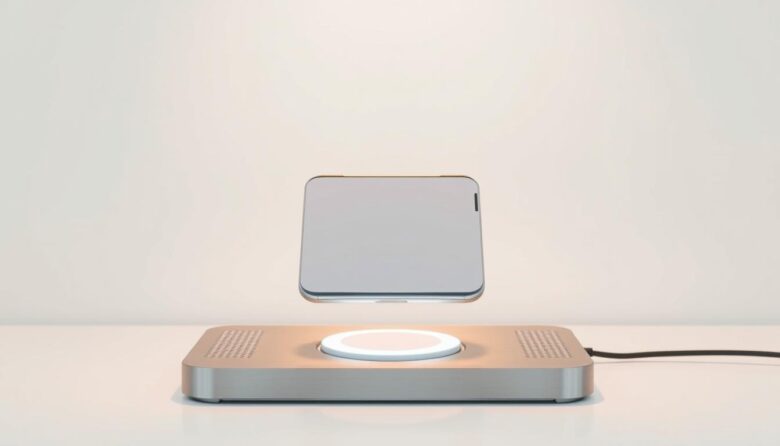Modern mobile devices face growing thermal challenges during demanding tasks. Extended gaming sessions, 4K video streaming, and fast charging generate significant heat buildup that impacts performance. This heat accumulation often leads to processor throttling and accelerated battery degradation over time.
This guide presents a technical solution combining thermoelectric technology with ergonomic design. The system uses industrial-grade components like Peltier plates and aluminum heatsinks to actively transfer heat away from devices. A built-in charging port ensures continuous power delivery while maintaining optimal temperatures.
Mobile gamers and content creators benefit most from this setup. Resource-heavy applications push processors to their limits, creating thermal stress that standard cases can’t address. The integrated cooling mechanism helps maintain peak performance during marathon usage periods.
Engineers designed this project to balance functionality with accessibility. Step-down converters and thermal paste applications demonstrate practical electrical engineering concepts. Users gain both immediate temperature reduction and long-term device protection through systematic heat dissipation.
This approach solves multiple pain points simultaneously. It provides stable charging access while preventing the performance drops that plague overheating gadgets. The final product serves as an essential tool for anyone relying on their mobile device as a primary workstation or entertainment hub.
Introducing an Innovative Phone Cooling and Charging Solution
High-performance mobile tasks generate heat that standard solutions can’t dissipate effectively. This technical challenge demands advanced thermal management systems capable of maintaining optimal operating conditions. The proposed solution combines active cooling technology with intelligent power delivery for comprehensive device protection.
Project Overview and Benefits
The system employs thermoelectric modules to redirect heat through aluminum conduction plates. Unlike passive methods relying on ambient air flow, this approach creates a temperature differential that actively pulls heat away from device surfaces. Integrated charging ports maintain power supply without compromising cooling efficiency.
Real-World Applications and Inspiration
Mobile gamers streaming live video content benefit from sustained performance during marathon sessions. Content creators editing 4K footage gain stability through consistent thermal regulation. In home office environments, the system prevents overheating during extended video conferences while keeping devices charged.
Field tests demonstrate practical effectiveness. One user achieved 15°F reductions during intensive tasks using conductive materials. Alternative approaches like phase-change compounds show temporary relief, but permanent solutions require engineered heat transfer pathways.
Gathering Materials, Tools, and Prepping Your Workspace
Building an effective thermal management system starts with selecting precision components. The setup requires industrial-grade parts designed for sustained heat transfer and electrical stability. Proper workspace organization ensures safe assembly while maintaining component integrity throughout construction.
Essential Components and Consumables
The thermoelectric cooler module forms the core of this thermal regulation system. Paired with a 12V heatsink and fan assembly, it creates active cooling through controlled heat displacement. An aluminum sheet serves as the primary conduction surface, transferring energy between devices and cooling elements.
Silicone thermal pads protect device exteriors while maintaining thermal contact. Two step-down converters independently regulate power to the cooling module and ventilation fan. The tripod holder’s adjustable design accommodates different device sizes without obstructing airflow.
Setting Up a Safe and Efficient Work Area
Users should arrange a well-ventilated workspace with dedicated zones for soldering and mechanical assembly. Keep flammable materials away from the soldering station, and use thermal adhesives in open areas to prevent fume accumulation. Position the fan side of the heatsink facing upward for optimal heat dissipation during testing.
Organize components by function – electrical parts separate from mechanical elements. Verify voltage outputs before connecting modules to prevent overloads. Secure the aluminum sheet firmly to the cooler’s top surface using industrial-grade adhesive for permanent bonding.
Detailed Step-by-Step Assembly Instructions
Constructing this thermal regulation system demands precision at every phase. Follow these technical guidelines to ensure proper alignment and electrical safety while maintaining peak cooling performance.
Attaching the Peltier Module and Heatsink
Spread thermal adhesive evenly across the heatsink’s top surface using a plastic applicator. Position the Peltier module carefully, applying firm pressure for 90 seconds to eliminate air pockets. Allow 20 minutes curing time before handling.
Secure the aluminum conduction plate using matching pressure techniques. This creates a direct thermal pathway between device surfaces and cooling elements. Avoid shifting components during adhesive curing phases.
Modifying the Holder and Securing Components
File the holder’s inner grooves until the Peltier assembly sits flush. Sand both contact surfaces with 220-grit paper before applying cyanoacrylate adhesive. Clamp the modified holder to the heatsink for 10 minutes.
Verify smartphone positioning aligns with the cooling module’s active zone. Leave 3mm clearance on each side for airflow circulation. Structural integrity remains intact through precise material removal.
Soldering, Wiring, and Component Calibration
Set the first converter to 5V output using a multimeter before fixing it with tape. Solder red/black wires to corresponding Peltier terminals, maintaining polarity. The second converter requires 13V calibration for optimal fan operation.
Connect both converters in parallel using 18AWG wiring. Route cables along the heatsink’s recessed channels, securing them with nylon ties every 2 inches. Final testing confirms simultaneous cooling activation and stable power delivery.
DIY phone cooling stand: Setup and Optimization
Optimizing thermal regulation systems requires balancing electrical output with thermal transfer efficiency. Proper configuration ensures devices maintain ideal temperatures during intensive tasks without energy waste. This phase focuses on refining component interactions through targeted adjustments.
Tweaking Stepdown Converter Settings for Optimal Cooling
Voltage adjustments prove critical for managing Peltier module intensity. Testing reveals 8V operation reduces condensation risks while maintaining 18°F temperature drops. Pair this with 13.5V fan settings for balanced airflow and noise control.
High-powered modules often overcool devices, creating moisture buildup. The TES1-4903 5V module provides safer cooling capacity for most smartphones. Its compact design pairs well with smaller heatsinks, reducing power consumption by 40% compared to bulkier alternatives.
Managing Airflow and Heat Transfer Effectively
Position cooling fans at 45-degree angles to heatsink surfaces. This orientation boosts air circulation while directing warm airflow away from device surfaces. Maintain 3mm clearance around components to prevent thermal recycling.
Removable thermal pads enable quick adjustments between different smartphone models. Apply 1mm-thick pads to ensure consistent contact without pressure damage. Regular surface cleaning maintains 95% thermal conductivity over extended use periods.
Wrapping Up and Looking Forward
Completing this thermal management project marks a significant advancement in maintaining device performance. Users gain professional-grade temperature control that outperforms basic passive solutions. The system’s modular design allows easy upgrades as new technologies emerge.
Cost-effective materials demonstrate how innovation thrives through accessible engineering. Temperature monitoring confirms consistent 15-20°F reductions during demanding activities like streaming or gaming. These results validate thermoelectric principles for everyday tech applications.
Future enhancements could integrate smart sensors for automatic adjustments. Wireless charging compatibility presents another exciting frontier. Such upgrades would further streamline the user experience while maintaining core cooling efficiency.
This build proves that effective thermal solutions don’t require expensive equipment. By combining charging capabilities with active heat transfer, it addresses two critical mobile device limitations simultaneously. The project serves as both practical tool and inspiration for future tech innovations.



